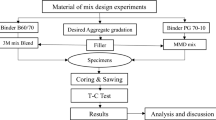Abstract
This study focused on the design of heat-resistant asphalt mixture for permafrost regions. Vermiculite powder with low thermal conductivity was used to replace some of the fine aggregates in the asphalt mixture to lower the thermal conductivity of asphalt mixture. Asphalt mixtures with different mass ratios (0, 3, 6, 9 and 12 %) of vermiculite powder were prepared for performance evaluation and thermal property evaluation. Wheel tracking test, low-temperature bending beam test, freeze–thaw splitting test and fatigue test were conducted to evaluate the influences of vermiculite powder on the high-temperature rutting resistance, low-temperature cracking resistance, moisture stability and anti-fatigue performance of asphalt mixture. Mathis TCI analyzer was used to analyze the influences of vermiculite powder on the thermal conductivity of asphalt mixture. Temperature monitor system was used to figure out the influences of vermiculite powder on the inside temperature of asphalt mixture. It is proved that vermiculite powder has no significant influences on the performances of asphalt mixture, while it obviously affects the thermal property of asphalt mixture. By the addition of 9–12 % vermiculite powder in asphalt mixture, the performances of asphalt mixture can still well meet the performance requirements for permafrost regions; the thermal conductivity can be reduced by 40–55 %; and the inside temperature of asphalt mixture can be lowered by 1–2 °C. It proves the feasibility of using vermiculite powder to produce heat-resistant asphalt mixture for permafrost regions.








Similar content being viewed by others
References
Sheng Y, Zhang JM, Liu YZ, Wu JM (2002) Thermal regime in the embankment of Qinghai-tibet highway in permafrost regions. Cold Reg Sci Technol 35(1):35–44
Peng H, Ma W, Mu YH, Jin L, Yuan K (2015) Degradation characteristics of permafrost under the effect of climate warming and engineering disturbance along the Qinghai-Tibet highway. Nat Hazards 75(3):2589–2605
Wu QB, Zhang ZQ, Liu YZ (2010) Long-term thermal effect of asphalt pavement on permafrost under an embankment. Cold Reg Sci Technol 60:221–229
Wu QB, Niu FJ (2013) Permafrost changes and engineering stability in Qinghai-Xizang plateau. Chin Sci Bull 58(10):1079–1094
Wu Q, Zhang T (2010) Changes in active layer thickness over the Qinghai–Tibetan plateau from 1995 to 2007. J Geophys Res Atmos 115(D09107):1–12
Yu QH, Liu YZ, Tong CJ (2002) Analysis of the subgrade deformation of the Qinghai-Tibetan highway. J Glaciol Geocryol 24(5):623–627
Zhang C, Wang HN, You ZP, Ma B (2015) Sensitivity analysis of longitudinal cracking on asphalt pavement using MEPDG in permafrost region. J Traffic Transp Eng 2(1):40–47
Niu FJ, Cheng GD, Ni WK, Jin DW (2005) Engineering-related slope failure in permafrost regions of the Qinghai-Tibet plateau. Cold Reg Sci Technol 42:215–225
Feng WJ, Ma W, Zhang LX, Wu ZJ (2003) Application of awning to roadway engineering in permafrost regions. Chin J Geotechnol Eng 25:567–570
Chen J, Sheng Y, Cheng GD (2006) Discussion on protection measures of permafrost under the action of engineering from the point of earth surface energy balance equation in Qinghai-Tibet plateau. Glaciol Geocryol 28:223–228
Sheng Y, Wen Z, Ma W, Liu YZ, Qi JL, Wu JC (2006) Long-term evaluations of insulated road in the Qinghai-Tibetan plateau. Cold Reg Sci Technol 45:23–30
Wen Z, Sheng Y, Ma W, Qi JL (2008) In Situ experimental study on thermal protection effects of the insulation method on warm permafrost. Cold Reg Sci Technol 53:369–381
Dong YH, Lai YM, Xu XT, Zhang SM (2010) Using perforated ventilation ducts to enhance the cooling effect of crushed-rock interlayer on embankments in permafrost regions. Cold Reg Sci Technol 62:76–82
Wu QB, Lu ZJ, Zhang TJ, Ma W, Liu YZ (2008) Analysis of cooling effect of crushed rock-based embankment of the Qinghai-Xizang railway. Cold Reg Sci Technol 53:271–282
Pan Y, Wu CZ (2002) Numerical investigations and engineering applications on freezing expansion of soil restrained two-phase closed thermosyphons. Int J Therm Sci 41:341–347
Wu JJ, Ma W, Sun ZZ (2010) In-situ study on cooling effect of the two-phase closed thermosyphon and insulation combinational embankment of the Qinghai-Tibet. Cold Reg Sci Technol 60:234–244
Sun BX, Yang LJ, Liu Q, Wang W, Xu XZ (2011) Experimental study on cooling enhancement of crushed rock layer with perforated ventilation pipe under airtight top surface. Cold Reg Sci Technol 68:150–161
Wang SL, Niu FJ, Zhao L, Li SX (2003) The thermal stability of roadbed in permafrost regions along Qinghai-Tibet highway. Cold Reg Sci Technol 37:25–34
Wang SJ, Huang XM (2012) Highway design theory and practice in permafrost regions. Science Press, Beijing
Zhang JW, Li JP, Quan XJ (2013) Thermal stability analysis under embankment with asphalt pavement and cement pavement in permafrost regions. Sci World J 2013:1–12
Ling TQ, Zhan SG, Li XL (2010) Study on light–colored technology of highway tunnel pavement. Adv Mater Res 168:211–216
Chen Z, Ma DC (2012) Effectiveness of solar heat reflective coatings in reducing asphalt concrete temperature. J Test Eval 40:740–745
Feng DC, Yi JY (2009) Study on mechanism and performance of tack and seal coat of thermal resistance for asphalt pavement. J Highw Transp Res Dev 26:1–5
Wang SJ (2008) Highway construction technology in the permafrost region of China. China Communications Press, Beijing
JTG F40-2004 (2004) Technical specifications for construction of highway asphalt pavement, China communications Press, Beijing
Acknowledgments
The study is financially supported by National Science and Technology Support Program (2014BAG05B04), National Natural Science Foundation of China (No. 51378006), Huoying dong Foundation of the Ministry of Education of China (No. 141076) and Excellent Young Teacher Program of Southeast University (2242015R30027).
Author information
Authors and Affiliations
Corresponding author
Rights and permissions
About this article
Cite this article
Ma, T., Zhong, Y., Tang, T. et al. Design and Evaluation of Heat-Resistant Asphalt Mixture for Permafrost Regions. Int. J. Civ. Eng. 14, 339–346 (2016). https://doi.org/10.1007/s40999-016-0039-9
Received:
Revised:
Accepted:
Published:
Issue Date:
DOI: https://doi.org/10.1007/s40999-016-0039-9




